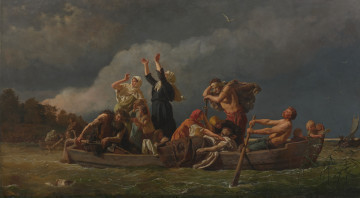
Landless. Pomeranians driven out by Germans to Baltic islands
1888
National Museum in Szczecin
Part of the collection: European classics of modernity
Material relics of prehistoric periods had already aroused curiosity in the Middle Ages, but their systematic study did not take place until the beginning of the modern era. After the 18th century fascination with the ancient cultures of the Mediterranean, interest in the mysteries hidden in the soil of Northern Europe grew. In German countries the pioneers of the description of the native antiquities (vaterländische Altertümer) were Karl Benjamin Preusker (Saxony) in the Romantic Age, and in the middle of the 19th century - Ludwig Lindenschmit the elder (Hesse). The latter, who was also active as a history painter, lithographer and drawing teacher, initiated the establishment of the Central Museum of Prehistoric and Early Modern Germanic and Roman Antiquities (today: Römisch-Germanisches Zentralmuseum) in Mainz and the Christian-Germanic National Museum (today: Germanisches Nationalmuseum) in Nuremberg (1852). From the very beginning prehistory, intertwined with modern art, was of great importance for the constitution of the modern nation and the state finally united in 1871. In the case of Pomerania, the politicisation of German archaeology stemmed from the desire to retain rights to territories where the sense of ethnic distinctiveness was strengthened or which had fallen to Poland after the end of the First World War. The Germanic-Slavic rivalry had already been the subject of treatises by the Berlin professor Gustaf Kossinna, and later also by his rival Wilhelm Unverzagt and his doctoral student and opponent Józef Kostrzewski. When Max Kühn immortalised the megalith of the funnel-shaped cup culture near Lonvitz in May 1926, therefore, he chose a motif of particular importance. Wrongly labelled the grave of the Huns and depicted in the company of a Proto-Germanic oak tree, the Gothic church in Vilmnitz and sheaves of grain set up by contemporary German peasants, he turned the rugged landscape into a patriotic landscape - a carrier of a civilisation that had lasted for thousands of years.
Szymon Piotr Kubiak
Author / creator
Dimensions
cały obiekt: height: 67 cm, width: 95 cm
Object type
painting
Creation time / dating
Creation / finding place
Identification number
Location / status

1888
National Museum in Szczecin

between 1957 — 1960
National Museum in Szczecin

between 1957 — 1963
National Museum in Szczecin
DISCOVER this TOPIC
National Museum in Lublin
DISCOVER this PATH
Educational path